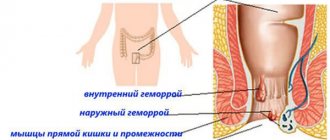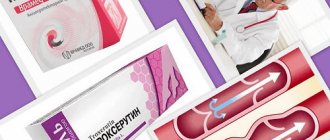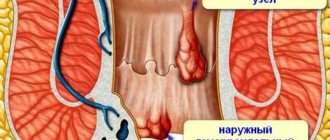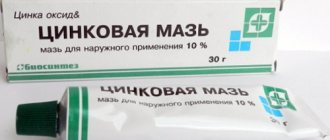Pharmacological properties
Pharmacodynamics
Phenylephrine hydrochloride has a local vasoconstrictor effect. This normalizes the relationship between blood flow to hemorrhoids and blood outflow from them, and also helps to reduce exudation, swelling, itching, serous discharge in hemorrhoids and other diseases of the anorectal area.
Pharmacokinetics
The drug is for local use. Phenylephrine, which is part of it, is inactivated by tissue MAO; inactive metabolites are excreted in the mucus or in small quantities by the kidneys.
Relief® line preparations and their release forms
Effective treatment of hemorrhoids may require the use of local vasoconstrictors, analgesics and anti-inflammatory drugs. The drugs from the Relief line have the listed properties.
The manufacturer offers a whole line of products, which includes rectal suppositories and ointments. Certain types of the drug are prescribed for certain types of hemorrhoids. This form of drug release, such as rectal suppositories, is used mainly for the treatment of internal hemorrhoids, and ointment is used in the presence of not only internal, but also external manifestations of the disease.
Directions for use and doses
For adults and children over 12 years of age, use the drug after hygiene procedures. Remove the protective cap from the applicator. Attach the applicator to the tube and squeeze out enough ointment to lubricate the applicator. Apply the ointment carefully through the applicator to the affected areas outside or inside the anus in an amount sufficient to treat the affected areas, up to 4 times a day, preferably in the evening, in the morning or after each bowel movement. Use until symptoms disappear. After each use, rinse the applicator thoroughly and place it in the protective cap. Do not use if protective coating is missing or damaged.
Which Relief® should you choose?
Suppositories and ointments, in which the active ingredient is phenylephrine, are used by specialists to treat internal and external hemorrhoids, which are accompanied by bleeding and itching.
In the presence of severe pain and burning, both forms of the drug Relief Advance are used (rectal suppositories and ointment).
Which Relief is better for hemorrhoids accompanied by anal itching, eczema and dermatitis of the perianal area? In this case, you should choose anti-inflammatory rectal suppositories Relief Ultra.
Overdose
It has not been described in medical practice and there is no data on systemic, including toxic, reactions of the body in response to rectal administration of the drug Relief®. However, with an overdose, an increase in the manifestations of adverse reactions is possible, especially with long-term use. Arterial hypertension, pain and discomfort in the heart area, palpitations, shortness of breath, non-cardiogenic pulmonary edema, agitation, convulsions, sleep disturbance, anxiety, paranoia, irritability, psychosis with hallucinations, weakness, anorexia, nausea, vomiting, oliguria, urinary retention may be observed. redness of the face, a feeling of coldness in the extremities, paresthesia, increased sensitivity, hyperglycemia, hypokalemia, reduced blood flow to vital organs, which can lead to deterioration of blood supply to the kidneys, metabolic acidosis, increased workload on the heart due to increased overall peripheral vascular resistance. Treatment is symptomatic.
Adverse reactions
This medicine is usually well tolerated, but in rare cases, adverse reactions due to phenylephrine hydrochloride may occur.
From the cardiovascular system: reflex bradycardia, arrhythmia, possible heart rhythm disturbances, increased blood pressure.
From the immune system: allergic reactions, including cross-reactions with allergies to other sympathomimetics, which can manifest as rash, itching, angioedema.
From the endocrine system: increasing symptoms of hyperthyroidism.
From the skin and subcutaneous tissues: contact dermatitis.
From the nervous system: dizziness, nervousness, headache, tremor, insomnia, feeling of fear, feeling of a rush of blood to the face.
At the site of application, possible irritation, hyperemia, rash, itching, swelling, moderate pain/burning if damaged or bleeding from the anus.
Methylparaben and propyl parahydroxybenzoate can cause allergic reactions (possibly delayed) and, in some cases, bronchospasm. Lanolin may cause local skin reactions (eg contact dermatitis). Benzoic acid is moderately irritating to the skin, eyes and mucous membranes.
Features of application
Use during pregnancy or breastfeeding
Since the safety of using Relief® (phenylephrine) during pregnancy has not been studied, the use of the drug is possible if, in the opinion of the doctor, the benefit to the mother outweighs the potential risk to the fetus/child.
Pregnant women should consult a doctor before starting to use the drug.
Because it is unknown whether topical use of Relief® (phenylephrine) can result in sufficient systemic absorption to cause measurable excretion in breast milk, the physician must determine the importance of the drug to the mother: whether cessation of breastfeeding or discontinuation of the drug is necessary. No studies have been conducted on the effect of the drug on fertility.
Children
The effectiveness and safety of the drug Relief® in children under 12 years of age have not been studied. No data available.
The ability to influence the reaction rate when driving vehicles or other mechanisms
There was no effect on the ability to drive vehicles or use other machinery.
Interaction with other drugs and other types of interactions
It should not be used together with other vasoconstrictors (by any route of administration), as well as with antihypertensive drugs (ß-blockers), since phenylephrine can cause severe hypertension in some individuals due to stimulation of α-adrenergic receptors.
Atropine sulfate blocks the reflex bradycardia caused by phenylephrine and increases the pressor response to phenylephrine. Concomitant use of phenylephrine with beta-blockers can lead to hypertension and excessive bradycardia with possible heart block. It should be used with caution with thyroid hormones, drugs that affect cardiac conduction (cardiac glycosides, antiarrhythmic drugs).
When used simultaneously with drugs that predetermine the removal of potassium, for example with some diuretics such as furosemide, hypokalemia may increase and decrease arterial sensitivity to vasopressor drugs such as phenylephrine.
Concomitant use of phenylephrine and other sympathomimetics can lead to additional stimulation of the central nervous system to an extremely high level, accompanied by nervousness, irritability, and insomnia. Seizures are also likely.
When using MAO inhibitors, you should consult a doctor before using phenylephrine in the anorectal area. MAO inhibitors used before the initiation of phenylephrine treatment potentiate the cardiac and pressor effects of the latter, since the metabolism of phenylephrine is reduced.
When using the drug Relief® topically, rectal ointment, in the anus, the excipient white soft paraffin can reduce the strength and safety of latex condoms used simultaneously with the drug.
Relief rectal ointment 2.5 mg/g 28.4 g No. 1
Name
Relief.
Description
Yellow ointment without foreign substances with a weak characteristic odor.
Main active ingredient
Shark liver oil + phenylephrine.
Release form
Rectal ointment.
Pharmacological properties
Phenylephrine hydrochloride is an alpha-adrenomimetic, has a local vasoconstrictor effect, which helps reduce exudation, tissue swelling, and itching in the anorectal area.
Indications for use
As a symptomatic remedy for hemorrhoids, anal fissures, anal itching.
Directions for use and doses
Use the drug after hygiene procedures. Remove the protective cap from the applicator. Attach the applicator to the tube and squeeze out a small amount of ointment to lubricate the applicator. Apply the ointment carefully through the applicator to the affected areas outside or inside the anus up to 4 times a day (in the morning, at night and after each bowel movement). After each use, rinse the applicator thoroughly and place it in the protective cap. Children under 12 years old - as prescribed by a doctor. The dose used for self-treatment of hemorrhoids in adults and children over 12 years of age should not exceed 2 mg of phenylephrine hydrochloride (1 g of ointment contains 2.5 mg of phenylephrine hydrochloride) per day. It is not recommended to exceed the indicated dose without a doctor's prescription.
Use during pregnancy and lactation
The drug is not recommended for use during pregnancy and lactation.
Impact on the ability to drive vehicles and operate machinery
It is recommended to exercise caution due to the possible development of adverse reactions from the nervous system.
Precautionary measures
For patients with arterial hypertension, cardiovascular diseases, thyroid diseases, angle-closure glaucoma, diabetes mellitus, liver diseases, pancreas diseases, urinary disorders (for example, in the case of prostatic hyperplasia), the drug can be used only after consulting a doctor; during treatment it is necessary doctor's supervision. Before prescribing the drug, the doctor should clarify the allergic history, including allergic reactions to other sympathomimetic drugs. In case of heavy bleeding from the anus or lack of therapeutic effect when using the drug, you should consult a doctor.
Interaction with other drugs
The drug should not be used simultaneously with other vasoconstrictors (regardless of the route of administration), as well as with antihypertensive drugs (13-blockers). Atropine sulfate blocks reflex bradycardia caused by phenylephrine and increases the pressor response to phenylephrine. The simultaneous use of phenylephrine with B-blockers can lead to arterial hypertension and severe bradycardia with possible heart block. Caution should be exercised when using the drug Relief together with thyroid hormones and drugs that affect cardiac conduction (cardiac glycosides, antiarrhythmic drugs). When used simultaneously with drugs that cause potassium excretion (for example, with diuretics such as furosemide), hypokalemia may increase and sensitivity to vasopressor drugs such as phenylephrine may decrease. The simultaneous use of phenylephrine and other sympathomimetic drugs can lead to additional stimulation of the central nervous system, which is accompanied by agitation, irritability, insomnia, and the possible development of a convulsive attack. Relief should not be used simultaneously or within 14 days after stopping treatment with MAO inhibitors.
Contraindications
Hypersensitivity to the components of the drug, severe arterial hypertension, tachysystolic heart rhythm disturbances, decompensated heart failure, cardiac conduction disorders, severe renal and/or liver failure, thyrotoxicosis, acute pancreatitis, thromboembolism (including previous ones), granulocytopenia, simultaneous use with monoamine oxidase inhibitors (MAOIs) or within 14 days after stopping treatment with MAO inhibitors.
Compound
Active ingredient: phenylephrine hydrochloride 2.5 mg/g. Excipients: mineral oil, petrolatum, methyl parahydroxybenzoate (E218), propyl parahydroxybenzoate (E216), anhydrous lanolin, benzoic acid (E210), corn oil, glycerol, lanolin alcohols, paraffin paraffin (58/60), thyme oil, vitamin E, white wax, purified water.
Overdose
If the recommended single and daily doses are significantly exceeded, a tendency to hypercoagulation may occur. In case of overdose, the following disorders are possible: arterial hypertension, pain and discomfort in the heart, palpitations, respiratory disorders, non-cardiogenic pulmonary edema, agitation, convulsions, sleep disturbances, anxiety, irritability, psychosis with hallucinations, general weakness, anorexia, nausea, vomiting, oliguria, urinary disorders, facial flushing, feeling of coldness in the extremities, paresthesia, hyperglycemia, hypokalemia, decreased blood flow to vital organs, which can lead to deterioration of blood supply to the kidneys, metabolic acidosis, increased workload on the heart due to increased total peripheral resistance. Treatment is symptomatic.
Side effect
The following adverse reactions are possible: From the cardiovascular system: reflex bradycardia, heart rhythm disturbances, increased blood pressure. On the part of the immune system: hypersensitivity reactions, including cross-type reactions in the case of allergic reactions to other sympathomimetic agents, which can manifest as skin rash, itching, angioedema, contact dermatitis. From the nervous system: dizziness, nervousness, headache, tremor, insomnia, anxiety, feeling of hot flashes. From the skin and subcutaneous tissues: contact dermatitis, hyperemia, skin rash, itching, swelling, pain, burning. Reporting Adverse Reactions If you experience any adverse reactions, consult your physician. This recommendation applies to any possible adverse reactions, including those not listed in the package insert. You can also report adverse reactions to the Adverse Drug Events Information Database, including reports of drug failure. By reporting side effects, you can help provide more information about the safety of the drug.
Storage conditions
At a temperature not exceeding 25 °C, out of the reach of children.
Buy Relief ointment rect. 2.5 mg/g in tubes 28.4 g in pack. No. 1 in pharmacy
Price for Relief ointment rect. 2.5 mg/g in tubes 28.4 g in pack. No. 1
Instructions for use for Relief ointment rect. 2.5 mg/g in tubes 28.4 g in pack. No. 1
Storage conditions
Store out of the reach of children at a temperature not exceeding 25°C.
Shelf life: 2 years.
Opening the tube and starting to use the drug does not affect the shelf life provided that it is tightly closed with a cap each time after use. Do not use after the expiration date stated on the package.
Product description certified by the manufacturer Famar (Delpharm)
.
Verified
Sevryukov Alexander Viktorovich
Note!
Description of the drug Relief ointment rectal. 28.4g tube on this page is a simplified author’s version of the apteka911 website, created on the basis of the instructions for use.
Before purchasing or using the drug, you should consult your doctor and read the manufacturer's original instructions (attached to each package of the drug). Information about the drug is provided for informational purposes only and should not be used as a guide to self-medication. Only a doctor can decide to prescribe the drug, as well as determine the dose and methods of its use.
The difference between Relief® drugs
Let's take a closer look at how the candles in the Relief line differ from each other. The following rectal suppositories of this line are produced:
- Relief, the active ingredient of which is phenylephrine, which has a vasoconstrictor effect, which reduces swelling, itching and bleeding.
- Relief Advance is a local anesthetic used to treat local pain syndrome.
- Relief Ultra, the active ingredient in which is hydrocortisone acetate, an anti-inflammatory component used to treat itching and eczema of the anorectal area, and zinc sulfate, which is used to accelerate healing.
Now let's figure out what Relief ointments are. The manufacturer produces two types of the drug in this dosage form. The difference between them, as with rectal suppositories, lies in the composition and therapeutic effect.
There are such types of Relief ointments on sale as Relief ointment with phenylephrine, which has an anti-edematous and hemostatic effect. And also Relief Advance ointment, with benzocaine, which has an analgesic effect. Each of them has its own area of application.









